Recent Posts
-
Real Crimes and the Coming Violence
September 6, 2025
-
Whither Modern Life?
June 27, 2025
-
What the Hell
June 18, 2025
-
As Darkness Engulfs Us
April 6, 2025
-
AI, Risk, and Work
January 17, 2025
-
“Things Are in the Saddle, and Ride Mankind”
December 29, 2024
-
Forgotten Futures in Seattle
December 12, 2024
-
Autocracy Defeats Neoliberalism
November 14, 2024
-
History… We’re Soaking in It!
October 2, 2024
-
A Numbing Spectacle
September 22, 2024
|
 I am popping in to recommend a listen for the 99% Invisible podcast on the Orange Alternative (which helped bring down the Polish military dictatorship in the late 1980s and ultimately ushered in the post-Communist era), which was centered around Wrocław in southwestern Poland. It’s a lovely radio show, full of inspiring history, and usefully brings it into the present by telling us about the “Little Picketers”—small clay statues holding signs that are popping up all over Russia as a kind of small, everyday dissent against the Ukrainian war. I am popping in to recommend a listen for the 99% Invisible podcast on the Orange Alternative (which helped bring down the Polish military dictatorship in the late 1980s and ultimately ushered in the post-Communist era), which was centered around Wrocław in southwestern Poland. It’s a lovely radio show, full of inspiring history, and usefully brings it into the present by telling us about the “Little Picketers”—small clay statues holding signs that are popping up all over Russia as a kind of small, everyday dissent against the Ukrainian war.
 A few images of “Little Picketers” that The Nation published, at least a couple originated with The Moscow Times. At the end of this post I’ll put the unfinished video of a journey through the last days of the East Bloc by the “Anti-Economy League of San Francisco”—we went to warn our political friends in East Germany, Poland, and (then-)Czechoslovakia about the coming disaster of “freedom.” That was our logo at upper left (taken from Oscar Bernal’s back cover of Processed World #8).
The Orange Alternative, well-presented in the 99% Invisible episode, was very inspiring to us when we learned about it. Using the symbol of a smurf, the movement grew by leaps and bounds and filled the streets in many places, especially Wrocław, using humor, ridicule, and festival to reduce the military dictatorship to the butt of a joke. 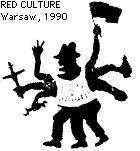 These days it’s hard to laugh in the face of the Russian onslaught on Ukraine, but we have to admit that meeting military might with the same is basically destroying the country. As Steven Cohen usefully analogized on the New Yorker Radio Hour, say you live in a big house with 10 rooms. A big bully comes barging in and takes two rooms, wrecks them, and from them begins to wreck the rest of your house. You need your house. They don’t. They have one behind that is basically safe and untouched. How long can you endure the destruction before you have to make an unpleasant deal? These days it’s hard to laugh in the face of the Russian onslaught on Ukraine, but we have to admit that meeting military might with the same is basically destroying the country. As Steven Cohen usefully analogized on the New Yorker Radio Hour, say you live in a big house with 10 rooms. A big bully comes barging in and takes two rooms, wrecks them, and from them begins to wreck the rest of your house. You need your house. They don’t. They have one behind that is basically safe and untouched. How long can you endure the destruction before you have to make an unpleasant deal?
It’s worse of course, because the United States has been up to no good since the fall of the Soviet Union. It’s perfectly true that the U.S. pushed NATO up against the borders of Russia, violated many of the pledges made when the Soviet Union imploded, and have surrounded Russia in a way that is almost designed to provoke a belligerent response. Blowing up the Nordstream gas pipelines (as Seymour Hersch has reported) shows the real U.S. agenda: to push Europe back under its nuclear and economic hegemony. Biden seems like a baffled old man a lot of the time, but this foreign policy is continuous with the priorities of the American establishment stretching back well into the Cold War. We haven’t even mentioned how much money is pouring into the coffers of the biggest war contractors, how much they’re running down stocks of weapons that were nearing their sell-by date, and how this is another goosing of the Military Industrial Complex. 
I don’t have time to go on at this moment, so for once I’ll just post this and let it be a brief provocation. (In other news, I have a final first draft of my novel, and it’s being evaluated by a publisher and, separately, a screenwriter! Fingers crossed for good news in the next month or two.)
OK, here’s the long-lost unfinished half hour of our forgotten journey to Eastern Europe in 1990:
And here is the article, written by myself and Michael Whitson (then still using the moniker Med-o), but never published until now!
The Anti-Economy League of San Francisco and Its Heroic, Revolutionary Tour of East Berlin, Szczecin, Gdansk, Warsaw, Wroclaw, and Prague, May-June 1990
We weren’t going to just go over there and be good tourists and take a lot of pictures, NO WAY! We gave our trip a lot of thought and preparation. A couple months before leaving, we settled on our name —“The Anti-Economy League of San Francisco.” First we prepared a leaflet full of broad questions and a bit about ourselves and mailed it to a wonderful mailing list provided by Bob McGlynn of the New York “Neither East Nor West” group.
As we awaited replies we busily produced or acquired an array of goods to take along as gifts when we crossed into the Zone of Consumer Deprivation. We spent several weekends making home-made Anti-Economy League t-shirts and printed up some Anti-Business Cards to go with them. Realizing our new friends wouldn’t have a nearby K-Mart to buy indelible markers, masking and scotch tape, pushpins and thumbtacks, cassettes, and other useful items, we tried to load up on them too. And of course a half pound of precious coffee for each host along the way. Med-o went first, in early April and looped around through Poland, Prague, Budapest, and Zagreb before meeting up with me in Frankfurt-am-Mein back in the West in late May. Along the way he wrote and occasionally telephoned with his impressions. For instance, he wrote from Prague in early May, “it’s certainly true that most urban Czechs are overjoyed to see the Communists out. But, unlike Poland, it’s a different story in the countryside and towns where 75% of the population live. The standard of living has been relatively high there, and that provincial, orderly, stable life (so boring to us) is what most, except some youth, want… Most of those I’ve met in Prague with some pizzazz are liberal artists and/or yearning yuppies. Many are politically progressive—but unable to envision anything beyond ‘The (free-market) Economy,’ or bourgeois democracy. Sort of like home, eh?”
Continue reading War and Anti-War
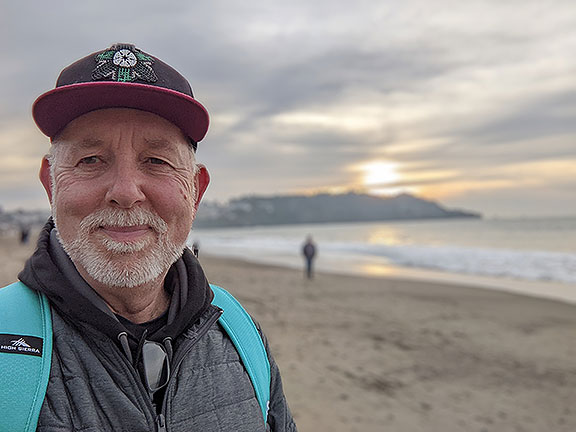 At Baker Beach on a cross-Presidio walk the day after Xmas. Happy new year friends. It’s been a good long while since I blogged. I just posted before this the review essay I wrote about two anarchist books that was originally published at The Fabulist. Having written three such essays for my pal Josh Wilson over there, I haven’t had much time for this blog. A bigger reason of course is that I’ve just hit 81 chapters and 270,000 words on my new novel, and I’m still not done! Sheesh! It’s been a year of pretty diligent writing, so that is gratifying. Like most writers, I go back and forth between thinking I’ve got something pretty good going and the vertiginous sensation that it’s a huge pile of crap and I’ve wasted a year writing an irredeemably long shaggy dog story that suffers from too many subplots and way too many characters. I guess you’ll all get a chance to cast judgment eventually!
I write this as the Republicans continue to demonstrate their fealty to … what exactly? In this case, they don’t seem to be able to wield power, which I thought was the whole point of their growing disdain for elections and majorities. Now the teensy minority of the demonstrably insane are being allowed to tyrannize the rest of their own party, not to mention the rest of congress—I never thought I’d say this, but this is a moment when we could use Willie Brown! He pulled off an unprecedented maneuver, gaining support from a few Republicans to keep him in the California Assembly Speaker’s chair when the Democrats had narrowly lost their majority back in 1994. I find it hard to believe that there aren’t at least 10 to 20 Republicans in Congress who want no part of the Boebert/Gaetz Circus, who would see their interest in cutting a deal with Democrats to ensure a functioning institution for the next two years. Not that I expect anything from any of these people, either Repubs or Dems. It’s all basically a club of the rich in service of the ultra-rich (with a few obvious exceptions to make it seem legit). And therefore, beyond the fascinating spectacle, which is more like sports than politics, I don’t really give a shit what they do. Nothing good will come of any of it, regardless.
Writing my novel about catastrophic weather and earthquakes and floods—and then parts of the neighborhood got flooded last week! Over 10 inches of rain in San Francisco, the most since 1871! And more to come. Weird to be writing detailed descriptions that weeks later come to life! So it goes.
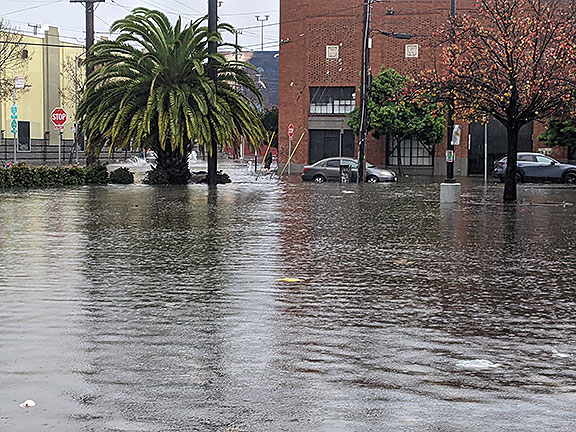 Mission Creek roared back to life during the deluge on Dec. 30-31, 2022. I called this “Lake Office Supplies” after the defunct store whose parking lot we’re looking at near the corner of 14th and Harrison. 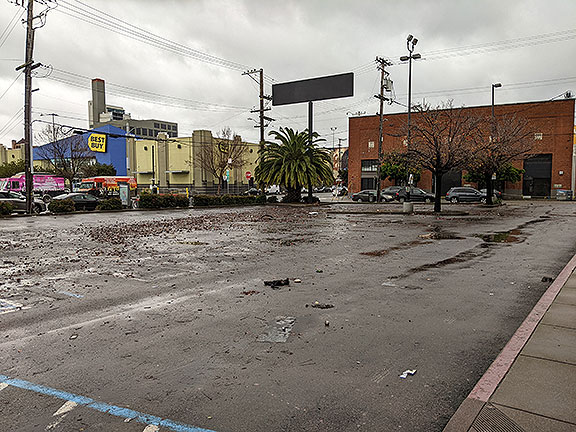 A few days later it was pretty well cleaned up. 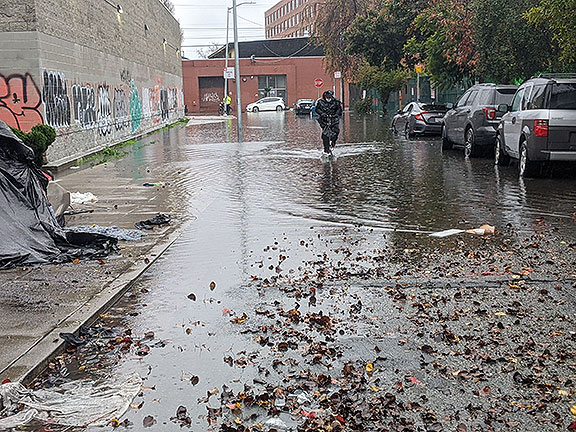 The alley between Rainbow Grocery and the office supplies place was under water, and of course Rainbow had to close due to flooding earlier this same morning. 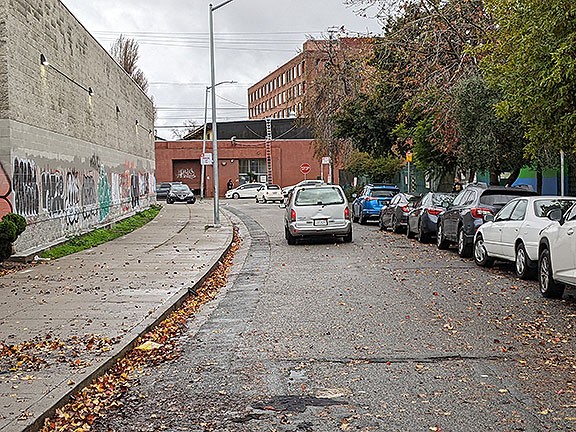 Back to “normal” a few days later. This essay, though, is about a few books I just read that go considerably beyond the tired repetition of old political dogma, at least in part. All three are published by Verso, who I have a bad attitude about from their poor treatment of Bad Attitude: The Processed World Anthology 32 years ago! But they do publish a lot of good books nowadays!
Before the pandemic Kate Soper wrote her book Post-Growth Living: For an Alternative Hedonism (2020); with the pandemic underway three degrowth proponents, Mathias Schmelzer, Andrea Vetter, and Aaron Vansintjan published The Future is DeGrowth: A Guide to a World Beyond Capitalism (2022); similarly, lefty geography professor Matthew Huber penned his useful Climate Change as Class War: Building Socialism on a Warming Planet (2022) during the pandemic. In interesting ways these books are in conversation with each other—perhaps that’s why they all issued from Verso.
The pitch for a hedonic approach to daily life at the heart of Kate Soper’s book immediately appealed to me (the title of this blog, an old slogan from the 1980s, has been a watchword for me ever since). She lays it out right at the beginning: “We need, in short, to challenge the presumption that the work-dominated, stressed-out, time-scarce and materially encumbered affluence of today is advancing human well-being rather than being detrimental to it.” (p. 2) Elsewhere she sensibly reminds us of a dimension systematically ignored by most of these discussions: “whenever we speak of the contemporary consumer’s pleasure, we should also speak of displeasure and of delights we do not enjoy. That side of the hedonist account has received scant representation, not least some of the ‘other pleasures’ we are presently going without.”
Sadly, her description of these other pleasures fell short for me, perhaps because I’ve made a similar argument for years. One of her most detailed examples involved the creation of cycle paths that lead to more people bicycling and enjoying more of their physical and mental lives as a result; a perfectly good example but it being so familiar to me it felt quite inadequate and even banal. Elsewhere she gestures to the pleasures of enjoying free time, engaging with work in deeper and more pleasurable ways, slowing down to enjoy cooking, reading, walking, etc.–all perfectly reasonable.
She doesn’t really address the problem that the vast majority of people in the so-called “developed world” are not enjoying the affluence she refers to, belying her own class position. People working two or three jobs are rarely in any position to cut their rent by 1/3 or stop car payments, or [fill in the blank]—and then take time to enjoy gardening or bicycling instead. By extension, a great number of the intellectuals and activists that have embraced a degrowth agenda, centering the critique of consumption, affluence, and profligate and wasteful use of resources, have shown a frustrating inability or refusal to examine the role of class in the reproduction and maintenance of all the problems they detail. Instead, we have Soper arguing,
Continue reading For Full Enjoyment, Not Full Employment!
This was originally published on The Fabulist, Nov. 24, 2022
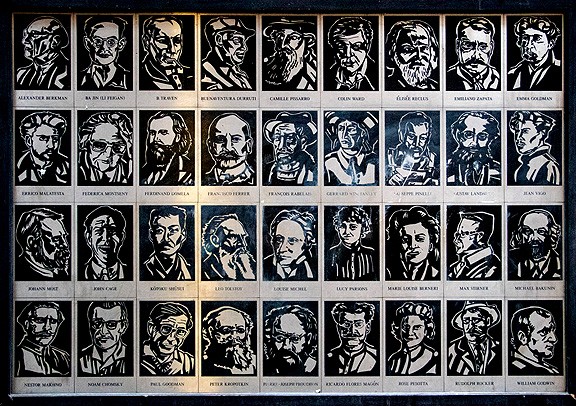
The Impossible Community: Realizing Communitarian Anarchism
By John P. Clark, PM Press (2022)
Buy this book on Bookshop.org
Overcoming Capitalism: Strategy for the Working Class in the 21st Century
By Tom Wetzel, AK Press (2022)
Buy this book on Bookshop.org
Given the hollow rhetoric surrounding contemporary uses of “freedom” and “democracy” by mainstream politicians from the center-left to the ultra-right, many people yearn for a coherent alternative politics that would give these terms vibrancy and real meaning in our everyday lives.
Such a yearning has been nurtured during several decades of grassroots activism, from the anti-nuke and anti-war movements to 2011’s #Occupy. All these dynamic movements were shaped by self-proclaimed anarchists, who inspired many people to associate themselves with the venerable philosophical tradition without fully grasping what it has meant historically, nor more practically in the here and now.
To be sure, anarchism has never been a unified, homogeneous political idea. Efforts to define and enclose it invariably engender harsh criticisms from others who embrace the term with equal fervor.
Two new books from anarchist writers await the eager explorer. If you are more inclined to a densely philosophical approach that foregrounds a communitarian and ecological focus, the just-published second edition of John P. Clark’s The Impossible Community: Realizing Communitarian Anarchism (PM Press: 2022) is a challenging and rewarding volume. If you prefer a prosaic and accessible tone, that roots itself in a dogged (and sometimes dogmatic) adherence to centering “the working class,” then Tom Wetzel’s Overcoming Capitalism: Strategy for the Working Class in the 21st Century (AK Press: 2022) is a better place to start.
Both books advance deeply thoughtful critiques of the system of domination in which we live, albeit in strikingly different language and emphasis. And both writers consistently advocate for a transformed organization for our political, economic, and social lives rooted in a bottom-up, egalitarian, and truly self-directed logic. Both writers categorically reject the State and government as they exist, as well as the corporations and bureaucracies that functionally control the lives of most of the people on the planet through the deeply corrupt and complex system of global capitalism.
Most anarchist thinkers probably agree with these general concepts. What struck me as I plowed through their volumes was how distinctive these two writers are in spite of their areas of agreement.
Not only do they write very differently and emphasize very different historical moments, but they also foreground social and historical agency in remarkably different ways. For anyone seeking an “anarchist path” these two authors present formidable issues to be wrestled with. Yet neither of these hard-working anarchist thinkers left me feeling convinced about their visions, nor hopeful that their book would inspire others to embark on a life dedicated to revolutionary change.
I hope I’m wrong!
Continue reading So You Think You’re An Anarchist?
|
Hidden San Francisco 2nd EDITION!

NEW 2nd EDITION NOW AVAILABLE!
Buy one here
(Pluto Press, Spring 2025)
|
 I am popping in to recommend a listen for the 99% Invisible podcast on the Orange Alternative (which helped bring down the Polish military dictatorship in the late 1980s and ultimately ushered in the post-Communist era), which was centered around Wrocław in southwestern Poland. It’s a lovely radio show, full of inspiring history, and usefully brings it into the present by telling us about the “Little Picketers”—small clay statues holding signs that are popping up all over Russia as a kind of small, everyday dissent against the Ukrainian war.
I am popping in to recommend a listen for the 99% Invisible podcast on the Orange Alternative (which helped bring down the Polish military dictatorship in the late 1980s and ultimately ushered in the post-Communist era), which was centered around Wrocław in southwestern Poland. It’s a lovely radio show, full of inspiring history, and usefully brings it into the present by telling us about the “Little Picketers”—small clay statues holding signs that are popping up all over Russia as a kind of small, everyday dissent against the Ukrainian war.
 These days it’s hard to laugh in the face of the Russian onslaught on Ukraine, but we have to admit that meeting military might with the same is basically destroying the country. As Steven Cohen usefully analogized on the New Yorker Radio Hour, say you live in a big house with 10 rooms. A big bully comes barging in and takes two rooms, wrecks them, and from them begins to wreck the rest of your house. You need your house. They don’t. They have one behind that is basically safe and untouched. How long can you endure the destruction before you have to make an unpleasant deal?
These days it’s hard to laugh in the face of the Russian onslaught on Ukraine, but we have to admit that meeting military might with the same is basically destroying the country. As Steven Cohen usefully analogized on the New Yorker Radio Hour, say you live in a big house with 10 rooms. A big bully comes barging in and takes two rooms, wrecks them, and from them begins to wreck the rest of your house. You need your house. They don’t. They have one behind that is basically safe and untouched. How long can you endure the destruction before you have to make an unpleasant deal?

















